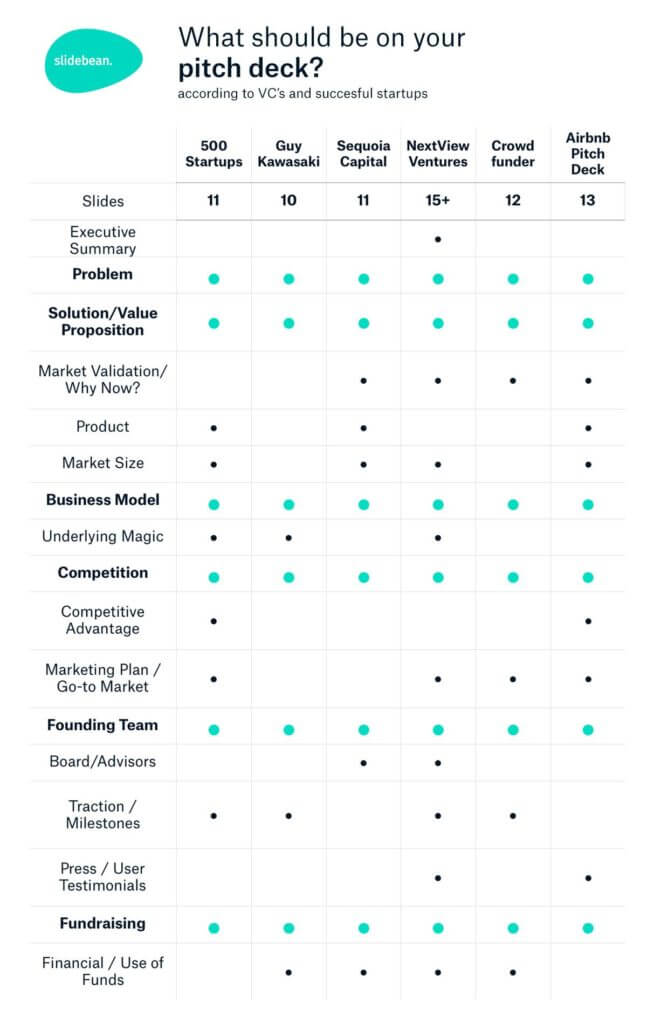As a freelancer, entrepreneur, or any other form of hustler, you never know when the opportunity will arise to pitch an idea. I know because I’ve been there.
That interesting conversation at the coffee shop could turn out to be a big deal investor.
Your gym partner mind end up being the exact type of person you’ve been trying to sell to.
Or you might have finally heard back from that startup accelerator you’ve been hounding for months on end about getting a meeting.
The opportunities are everywhere, and unfortunately we can’t always control when they come up. Which is why you always need to be prepared to pitch.
As a full-time consultant running my own business alongside multiple side projects, I can’t even begin to express the importance of learning how to pitch an idea well—both to potential investors and even more importantly, to your early customers.
I’m constantly out there pounding the pavement, pitching my services to startups all over the world. Sure, I’ve gotten my fair share of rejections. But in the end, each failure helped me tailor my own pitch to the point where I’ve been able to land contracts with companies like LinkedIn, Intuit, Zendesk, and Close.io.
Through my countless pitches, I’ve learned there are time-tested rules to successful pitching that you need to follow if you want to have the best chance of catching a big fish.
Which is why I’m so excited to share some incredible resources on how to craft and present a winning pitch from my friends over at Slidebean.
For the past 4 years, Slidebean has helped over 150,000 freelancers, startups, and entrepreneurs create beautiful, professional pitch decks, using templates and formulas from AirBnB, Guy Kawasaki (Chief Evangelist at Apple), 500 Startups, and more. Over 1.5 million slides have been made on Slidebean, helping them get coverage from sites like TechCrunch, The Next Web, and Business Insider.
If When you need to make a pitch deck, build it with one of Slidebean’s templates that are already proven to land investors and early customers.
So what are we waiting for? Let’s jump into how to research, craft, and present a winning pitch to both investors and customers.
Stage 1: Understand what makes a compelling pitch
Before we get into any specifics, we need to talk about the most basic foundation when it comes to learning how to pitch an idea—what makes a pitch interesting?
Shark Tank’s Robert Herjavec recently shared with me, his advice on capturing the attention of your target audience right from the start:
“You have 90 seconds, if you’re lucky. If you can’t make your point persuasively in that time, you’ve lost the chance for impact. Facts and figures are important, but it’s not the only criteria, you must present in a manner that generates expertise and confidence.”
As you can see (and as you’ve probably learned for yourself already), there’s no universal pitching template you can just plug your information into and get the instant results you want.
Learning the art of how to pitch an idea is much more nuanced than that.
However, that doesn’t mean you need to start from scratch every time. Good pitches all share certain characteristics that you can borrow, emulate, or ignore depending on who you’re pitching to and what you’re looking for:
- A good pitch balances business and emotional needs. Whether you’re pitching to a company, an investor, a customer, or a potential partner, you have to hit them on both emotional and business levels. Without this, your pitch is almost certain to fall flat.
- A good pitch is succinct. In most cases you only have a few seconds to capture someone’s attention and get your point across. Focus and momentum are your friends.
- A good pitch tells a story. Humans have been telling tales for thousands of years. Which is why it’s a great idea for the flow of your pitch, whether verbal or in a slide deck, to follow a narrative pattern.
- A good pitch focuses on benefits. Value beats price every single time. Rather than focus on cost or features, your pitch needs to focus on the value you’re going to create for the person you’re pitching.
Alright, now it’s time to come down a bit from 30,000 feet and look at how to use this information in our pitch.
1. Know who you’re pitching to (and tailor your pitch accordingly)

Even though you’re pitching the same service or product every time, you can’t just memorize a few lines and go from there.
Each opportunity is different and you’ll need to tailor how you pitch to the person you’re pitching, the social situation, and their level of understanding and interest.
Author and business etiquette expert Jacqueline Whitmore likens pitching to playing an instrument: “You want to memorize the melody so you can improvise variations and still sound authentic instead of rehearsed.”
Jazz might sound like it’s being made up on the spot, but there’s years of theory and study behind each improvised line.
When you pitch and idea, you want it to sound the same: tailor-made just for that person, but with a solid backing of thought and attention based on your experience.
2. Understand their needs and motivations
To hit the emotional level that will really make your pitch fly, you need to understand just what motivates the person you’re pitching and what their needs are (hopefully more than just a good motivational quote or two).
As a founder or freelancer, you probably love talking about the features of your product or service. But here’s the thing: Customers and investors don’t really care about features. They care about results.
If you’re having trouble clarifying your product’s benefits, one way to do this is to look at your product through the Jobs to be Done methodology (JTBD). Created by Harvard Business School professor Clayton Christensen, JTBD says that instead of thinking about your potential customer or investor as part of a demographic, you should instead think of them as people looking to ‘hire’ someone or something to solve a problem they have.
Your product is what they’re looking to “hire.”
So ask yourself, what ‘job’ does the person you’re pitching to need done? And why is your solution right?
Knowing these important details will help you focus on the specific value you’re creating for the person you’re pitching to.
3. Go deep into what challenges they face
Once you understand their needs and motivations, you need to go a step further and look at the real challenges your audience faces on a daily basis. Don’t just get a surface-level understanding of this.
You need to be boots on the ground when it comes to truly understanding these challenges. Because once you do you’ll be able to talk with confidence about how you can solve it.
Also, being able to authentically empathize with the problems your audience is facing will make you more credible in their eyes. And as author and pitch coach Michael Parker says, “If they don’t like you, they won’t buy you.”
People act on emotion and then justify with reason.
Stage 2: Gather the tools and resources that will make your pitch stand out
If Stage 1 of our pitching process was getting a high-level view of what should be in our pitch and starting to do the research we need to make it compelling, our next move is gathering the resources and tools we’re going to need to actually put this pitch together.
Now, while your product and your personality will be your greatest tools in any pitch, we all aren’t passionate and persuasive speakers. The right tools (and a winning pitch deck template) will help augment our pitch, taking some of the heat off of us personally and letting our product do the talking.
Let’s look at a few of my favorite tools for pitching:
4. Create a beautiful and powerful presentation
At the very core of your pitch is the presentation or ‘pitch deck’.
And while we’re going to go deep on exactly what should be in your presentation later on, the tools you use to build and show off your presentation are incredibly important.
Powerpoint is so 90s, and if you’re selling a modern product to an informed user or pitching any VC you want something more advanced. That’s why my friend Caya founded Slidebean and set out to solve this problem. (Shameless friend plug alert!)

Slidebean is awesome because it lets you create stunning, professional presentation in minutes using curated templates that have worked for Guy Kawasaki, 500 startups, the founders of AirBnB, and more.
Because 65% of communication is nonverbal, they’ve built ways to easily and quickly make your presentation beautiful and on-brand, including a huge resource of images, icons, gifs, charts, and more to make sure your presentation pops.
And because pitching is always a work in progress, Slidebean lets you track the activity of your presentation to see if your prospects are really engaging with it and where they drop off so you can adjust for the next time you send it out.
5. Have an up-to-date rendering/mock-up of your product
There’s a reason that Apple stores let you play with every product they have on display.
Behavioral psychologists have discovered that creating an ‘ownership experience’ by letting a potential buyer ‘try before they buy’ is a powerful way to close sales. You can use this same technique in your pitch.
If you’re still in the design phase, creating a prototype or wireframes using tools like InVision, Marvel, or RedPen are great ways to show off the functionality and design of your tools without doing any actual coding to land on a great beginning presentation look—and these tools can be useful in things like designing a blog layout too.
If you’re making a physical product but haven’t actually created it yet, you can easily go to a freelance job website like 99designs, Flexjobs, SolidGigs or Upwork and find a designer who can make a beautiful 3D rendering for you while working from home.
6. Solicit testimonials from current users or investors

Being able to show social proof for your idea is an incredible tool to use when pitching.
It transfers the clout of the person using your product or service to you and shows investors and clients that there is a real market need for what you’re doing.
If you have customers, start by asking to go on quick calls and talk about their experience. Or send out a quick survey through Typeform or Google forms asking what they think and if it’s OK to share their comments to investors and potential customers.
Some questions you can ask include:
- Name, title, and website
- What problem were you looking to solve when you decided to try my product/service?
- What’s your favorite feature of my product/service?
- Is there anything that can be improved?
- Would you recommend it to friends and colleagues?
Not only will this give you important insight into how real people are using your product, but you’ll get some great soundbites you can share in your pitch. Take the example of this testimonial video I filmed with a reputable CEO, talking about my content marketing services as inspiration for shooting a quick, simple testimonial walking through the content marketing strategy I helped him to create and execute on.
If you don’t have any customers yet, you can still get social proof by simply starting a test group of friends and coworkers and have them try out your service and give you feedback you can share.
7. Film promotional or explainer videos
A picture’s worth a thousand words, and a video might just be worth 10,000.
A succinct, entertaining, and informative video showcasing how your product solves the challenges your audience has is another incredibly powerful tool to add to your pitch.
The video can be as simple as a screen recording with recorded audio, or as complicated as a full live-action production. However, know that the cost of putting together a legit video can get steep and so if you’re just starting out you might not need to go all out, or make one at all. In most cases, videos are nice-to-haves.
You can find video producers, studios, or animators on the freelance sites I posted above, or check out video-specific marketplaces like Video Pixie or Veed.me.
Stage 3: Build your winning pitch deck
We’ve done our research. We’ve gathered our tools and resources. Now it’s time to build the best pitch deck you can possibly create.
First some basics…
Your deck is a number of slides, usually between 10–20, that do all the things we’ve been talking about so far: They show that you understand your customer’s pain point. That you know you’re the best solution for them. And that you’re better than the options out there. All while telling an entertaining and engaging story.
Here’s a quick checklist of what should be on your pitch deck, from my friends over at Slidebean.

Clearly, putting your pitch deck together is no small task.
So the easiest place to start is by looking at people who have successfully pitched or who receive pitches on a daily basis.
A number of authors, venture capitalists, startup founders and evangelists have created different versions of what they consider required elements to a successful pitch presentation. Truth be told, it often depends a lot upon the specifics of your business idea, too.
We’ve gone through some of the most popular and well-known articles and resources on pitch decks and put together this list of the slides you must include in your deck.
8. Craft an exciting intro
You need to start off with a bang to grab your viewer’s attention.
And so your first two slides need to quickly get them engaged. Start with your company name, one ‘hero image’, and your tagline or elevator pitch—a 5-7 word blurb that distills what your company does.
Make sure to use images that directly relate to or complement what your company does, such as showing someone actively using your product or service, or the situation where someone would use it.
The goal is to bring the audience ‘into your world’ here—and supports the belief that investors are buying into the story of your company, not just the financial picture.
9. Explain the business opportunity
Next, we’re going to zoom out from the company and look at the market itself.
The business opportunity section of your pitch deck has three main components to it:
- Problem: Here’s where the storytelling starts. You’re establishing the status quo and convincing your audience that there’s a real problem here that you can solve. Remember all the research you did on understanding their needs, motivations, and challenges here. Ideally, you’ll present the ‘problem’ in 1-4 bullet points. Get to the point quickly.
- Solution/Value proposition: With the problem established, move onto how your product or service will fix it! List the 3 key benefits your solution provides.
- The Market: Just how many people need your solution? Here is where you’ll talk about the real addressable market for your product and what percentage of the market you’re looking to dominate.
10. Highlight the underlying business model
This is a crucial moment in your pitch, and one where a lot of entrepreneurs and freelancers make a mistake.
Your business model can be the most interesting or the most boring part of your company.
After the excitement of seeing a problem, showing the solution, and then talking about the potentially millions of people that will want to use what you’ve got, going into the details of how you’re doing that can be tiresome and cause people to lose focus.
Instead, keep this section short and visual (and if you want to explore validating the idea further at this point, start a blog to begin exploring related blog post ideas, sharing your concepts with others to gather their feedback and forge a path to eventually making money blogging). Explain your business model clearly with as few words as possible. Try to connect what you’re doing to another well-know company so that it’s easier to understand (i.e. ‘We’re the Uber of dog sitters’).
11. Answer why you can beat the market
Now comes the pivotal moment. Why you?

Here you’ll need to channel all your confidence and passion to explain to your audience that you understand your competition and that you’ve got a trick up your sleeve that will blow them out of the water.
There are 3 main points you want to address here:
- Competition: Who’s already in the ring? Acknowledging competition tells investors you’re on top of the market and that you have strategies in mind to beat the other options out there.
- Proprietary technology: What are your unfair advantages, IP, technologies and innovations that are unique to your company, and will KO the competition?
- Marketing plan: How are you going to promote your blog and get millions of readers? Outline your long-term blog business plan for customer acquisition and the strategies you’re going to use to get people to stand up and take notice.
12. Explain who you are and shape your story
It’s now time to get personal.
Quickly introduce the core team, or if it’s just you, talk about yourself.
What makes you the best person to do all the things you’ve just said you’re going to do?
Show all the skills your team has and how they complement each other. For most startups, the Hacker, Hustler, Hipster combo is ideal. And mentors/advisors? Unless you’ve got some heavy hitters they’re probably not worth spending too much time on here.
13. Cover your current traction
If your business opportunity and plan was a jab and your marketing strategies were a big right hook, your traction slide is the KO punch.
Pick your best metric and show it in the best way possible—part of this step is just showing that you know how to articulate what your goals are and that you can show progress towards them.
We’re looking for the kind of growth that makes investors scream ‘take my money’, so don’t be shy.
14. Make your ask incredibly clear
Lastly, you need to ask for what you’re after.
Is it an investment? A partnership? If so, what are the details of that?
This might not necessarily be a slide, but so many people lose momentum by being afraid to make the ask.
If you’ve done the work, this should be a no-brainer.
But you can’t expect your audience to stand up and offer you what you’re after. Be clear and to the point.
15. Keep it short
This might sound like a lot to cram into just 10–20 slides, and that’s because it is.
The hardest part about creating a compelling pitch deck is keeping it short and sweet (just like learning how to write a headline).
You want your audience to feel like they understand your business, but still have room to ask questions. Remember, The Gettysburg Address lasted less than 3 minutes.
Stage 4: Tweaking your pitch for customers, demo day, or an elevator pitch
What we’ve just gone through is the typical pitch deck you’d put together for an investor meeting or when talking to a potential client or customer.
But there are other pitching scenarios where you’ll want to switch up your style.

Let’s look at a few of the most common:
The Customer pitch
Unlike the investor pitch we just showed above, if you’re going out and trying to sell your product or service to a customer, you’ll want to change a few things.
Your intro and problem/solution are still very important, but you can probably lay off the market talk (they are the market after all).
And while your business model might be interesting to the client you’re going after, it’s probably better to spend most of your efforts explaining why you’re better than the competition.
Remember, you want to tell a story with them at the center. Help them envision how their lives would be better with your solution.
The Demo Day pitch
Another common pitching situation for startups is Demo Day—the event at the end of an accelerator program where anywhere from 10–30 companies get on stage and spend 3 minutes convincing a room full of investors why they should throw money at them.
Due to the short, high-pressure nature of Demo Day, you’ll want to condense your pitch into a few short sections:
- Catch their attention with a question: You’ve got 5 seconds to capture their attention. What question will make them look up from their phones and lean in?
- Show how much money you can make: We’re not going for subtlety here (Remember to know your audience and VCs pretty much only care about growth). Quickly talk about some impressive numbers like month-on-month growth, lifetime value of a user, total user base, or your annual run rate.
- Now it’s time for the problem and solution: It’s also time to get into storytelling mode. Show your problem and solution through a story about an actual user. Show the problem they had, the solution you provided, and the benefits they received because of it.
- Business model, market, growth: Momentum is key here, so move quickly but confidently through your model, how big the market is (and how much of it you can realistically capture), and the strategies you’ve going to use to grow.
- Team photo! Show the beautiful people behind the product. It’s probably smart to stick to just the core founders here and not talk about mentors or advisors unless it’s important.
Lastly, you’ll want these slides to be much more visual than a usual investor deck. You’re presenting to a whole room and having people squint to read text will lose their interest in a heartbeat.
The Elevator pitch
You didn’t think we’d forget about the mother of all pitches did you?
Although we’ve been going deep into all of the decks and pitches and tools you can use to present your idea, it’s always good to put together a solid elevator pitch for those times where you don’t have a captive audience, but you don’t want to miss the opportunity.
Your 30–60 second pitch needs to do a number of things in a very short amount of time. Here’s a few pointers:
- Have a clear goal: You don’t have time to wax poetic. Get to the point as quickly as possible.
- Be personable and natural: Even though you’re on a time constraint, you don’t want to sound like you’re just regurgitating memorized lines. We want jazz, not classical.
- Focus on results and benefits: Don’t make it about yourself. Show benefits. Tell stories. Prove you and your idea have value.
- Include a call to action: Offer them a chance to follow up with you later. The secret to selling is to leave the prospect wanting more.
Stage 5: Preparing to deliver your pitch
The pitch doesn’t stop after your last slide.
If all goes well, you’ll be facing questions and comments from investors and customers eager to get on board with what you’re selling.
So, as part of your pitch preparation, you need to be ready for questions, objections, and pushback.
16. Anticipate and answer key questions (before your audience asks)

“I know what you’re probably thinking right now…”
Your audience wants to be confident that you’ve thought your idea through. So show them you’ve come at it from all angles by anticipating their questions and answering them in your pitch.
To do this, try going through your presentation with Beginner’s Mind.
Forget everything you know about your business and the market and growth and strategies. Just look at it like you’re seeing it for the first time.
What questions do you have? Write these down and see if you can answer them somehow during your presentation.
17. Be ready to deal with objections and tough questions
Objections and tough questions aren’t necessarily negative.
In fact, they show that you’ve made your audience think critically about what you’re saying and what you’re offering.
However, to get them closer to saying ‘yes’ you need to be able to handle their objections with grace and ease. So before you head into a pitch session, try this 5-step exercise from Close founder Steli Efti:
- Write down the top 25 objections you’re facing in your market.
- Write down your best answers to each objection.
- Limit the answers to a max of 3 sentences.
- Have at least 10 people review your answers and give feedback.
- Test yourself to know these answer by heart.
Once you’ve already gone through the most common objections that are likely to pop up during your pitch, addressing them in real-time with your audience will be a breeze. Side note—this activity is also extremely helpful when learning how to write a blog post that’ll stand up to reader questions.
18. Rehearse, rehearse, rehearse…
Confidence is key when it comes to pitching.
Before you step on any stage or into any office with your presentation you should know it front to back. Try it out on your coworkers. On your partner. On your parents. Hell, try it out on your Starbucks barista. The more times you go through it, the more natural it’ll feel.
And when you’re practicing at home, speak out loud. Record yourself presenting and play it back.
What sounds weird? Where do you make mistakes?
It’s easy to skip over these issues when you’re reading silently but they become more and more prominent when you actually hear them.
…
A huge thanks to my friends over at Slidebean for helping me put together this epic resource on all things pitching.
I know there’s a lot here and we’re just barely scratching the surface.
But like most things in life, the best way to learn how to pitch is by actually doing it.
The more times you put together a pitch deck or get out in front of a group of people and talk about your ideas, the more comfortable you’ll get with the process and the more you’ll start to see what resonates and what works.
Now over to you!
What questions do you have about putting together a winning pitch deck that we might have missed?


40 replies to “18 Pitching Essentials: How to Pitch an Idea to Investors (and Early Customers)”
As someone that has been in sales the past few years to get myself through school I can see that most of these concepts are tried and true in my industry. Great article, keep it up Ryan.
Love hearing that, Sam. Thanks for the kind words! Good luck 🙂
Thank you preparing such a comprehensive article for the entrepreneurs, especially young ones.
I am not an entrepreneur but I am interested in how to present a product/idea in the best way.
Your article has many references of expert portals, so if someone wants to go into detail in one aspect s/he just shoud click the link. Thank you providing these variety of the valuable references.
Thank you again.
Zaim
Thanks for the support, Zaim! 🙏
The blog is very interesting and educative. I need need more of it to improve my level of understanding about business. Also to balance and the administrative weakness of my company
Thank you! 🙂